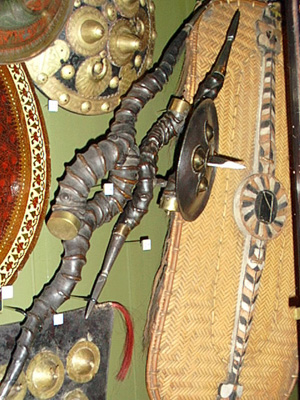
Indian Antelope Horn Shields

Indian shields on display in the Upper Gallery of the Pitt Rivers Museum, University of Oxford.
Extract from Feest's The Art of War
(p84)
Only a small metal buckler protects the hand of the warrior on the Punjabi márú. [this is seen on only one of the examples from Pitt Rivers' Screen 2]. Besides the shield's possible use as a parrying device, the metal-tipped antelope horn extensions and a central spike [present on one of the Screen 2 examples] made it a dangerous weapon as well.
Extract from Egerton's Indian and Oriental Armour
(p111 and 133)
Describing a similar shield to those on Screen 1, Egerton writes: '434. Parrying shield 'Márú' 'Mádú' or 'Singauta' (Cf Tayler Collection,
South Kensington Museum); consisting of a pair of black buck antelope
horns tipped with steel, and united at their butt ends, where
they are held. Used by the Bhils and Hindu fakirs. Taken at Lucknow.
L. 2 ft. 11 in.
Shields are generally made of steel, sambur-skin, buffalo, nylghau,
elephant and rhinoceros hide, which is most prized. The latter
is sometimes painted, figured with silver leaf, and varnished,
with bosses lightly ornamented with gold. Men of high rank, chiefly
Brahmins, who have an objection to wearing any kind of leather,
use a shield 'Dhal bafta' made of forty or fifty folds of silk,
painted red and ornamented (No 52 in the Codrington collection
was made at Jeypore in Rajpootana, in the time of Tippoo). The
raw rhinoceros hides are ornamented with silver or gilt bosses,
crescents and stars.'
He also describes another five similar shields:
'690. Parrying shield; 'Márú', consisting of a pair of antelope horns, tipped with small steel points, and united vertically at their butt ends, the point of junction being covered by a small circular and convex hand-guard of steel, ornamented with four bosses and a crescent of perforated steel. Delhi. L. of horns 3 ft. Diam. of guard, 8 in.
691. Parrying shield, 'Márú', antelope horns, tipped with steel; hand-guard of steel, enriched with silver mounts. Delhi. L. 3 ft. 6 in. Diam. of guard 8 in.
692. Parrying shield; antelope horns, tipped with steel, hand-guard of steel, bossed and damascened with gold. Punjab. L 3 ft. 5 in. Diam. 7 in.
693. Parrying shield; 'Márú' or 'Mádú'; antelope horns tipped with steel; hand-guard of brass, bearing four bosses and a crescent. Benares. L. of horns, 2 ft. 9 in. diam. of guard 9 in.
694. Parrying shield, 'Márú' or 'Mádú'; black buck horns, tipped with steel damascened with gold; small circular hand-guard of steel damascened with gold and bearing a large central gilt boss; grooved dagger blade projecting from under-guard. Datiah.
Extract from Robinson's Oriental Armour
(p115)
The madu or maru was a small fist-shield mounted upon a pair of roebuck horns with steel tips. It was primarily for parrying, and in some instances a pair of flamboyant [that is, flame-like] blades replaced the horns. The shields were of steel, chiselled and gilt, with four small bosses. Pairs of horns were also used, without a shield, for the same purpose. Their use was mainly confined to northern and central India.
Extract from Stone's Glossary
(p423)
MADU, MARU, SINGAUTA. An Indian parrying and thrusting weapon consisting of a pair of black buck horns fastened together with their points in opposite directions. Usually the horns overlap, but sometimes they are fastened to the opposite ends of a short handle. In either case the hand is protected by a small circular shield of leather or iron. The horns usually have steel points on the ends. It was used by the Bhils and other wild tribes and was a favorite with Hindu religious beggars. It was also used by swordsmen for guarding, being held in the left hand.
Extracts from Tarassuk and Blair's Complete Encyclopaedia
Fakir's crutch. A rather rare form of Indian mace or pick used, as the name implies, mostly by religious mendicants forbidden by law to carry arms. Usually made from a solid piece of steel, it has a short handle on one side of which is a head shaped like a hand holding an antelope's horn and, on the other, a serpent with a tiger's head. This 'crutch' is placed under the arm when a fakir is seated, and, should the need arise, can be a very efficient weapon.
Fakir's horns. A rare form of Indian weapon used by some fakirs, who as holy mendicants have never been allowed to carry ordinary weapons. It consists of a pair of black buck horns fastened together with their points going in opposite directions. The tips of the horns are sometimes furnished with steel spikes.
Madu. A rare form of Indian thrusting weapon combined with parrying shield, related to the FAKIR'S HORNS. Two horns of the black buck are fastened together with their points in opposite directions, sometimes with the tips armed with steel spikes, and a small shield of steel or leather is fastened in the middle to parry blows from the enemy's weapon.